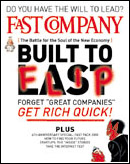 Hiring in India is not easy. Generically, it’s not easy anywhere. In perfect markets the demand side and supply side are mature and there is no hidden element. In India, just like the Bombay Stock Exchange, the buyers and sellers are in dark, few people know the right price until they get into a transaction. There are great candidates who almost never know great companies who could be a match.
Hiring in India is not easy. Generically, it’s not easy anywhere. In perfect markets the demand side and supply side are mature and there is no hidden element. In India, just like the Bombay Stock Exchange, the buyers and sellers are in dark, few people know the right price until they get into a transaction. There are great candidates who almost never know great companies who could be a match.
I have been actively hiring people for my new gig at Bitzer Mobile. We are trying to rope smart engineers to join our Bangalore office with expertise in C/C++, Java, PHP, Android, iOS with varied years of experience. Here are some observations as experienced in the last 30 days.
- Imperfect job boards. I wrote about this last year. Job boards are broken, monopolistic and owned by recruiters and mass e-mailers. They are good for bean counting your overall candidate flow with most of them a wrong match.
- No separate board for freelancers and short-term opportunities. Unlike US-based Dice, there are none in India in the forefront. This is partly because of our Indian mindset of job security. However, Hasgeek’s job board has an opportunity.
- Compensation disparity. The compensation range swings ultra-wide. For a PHP developer with 3 years experience it could range from INR 3L – 9L
- Recruiters hold the fort. A good number of candidates swirl around recruiters. The main reason is the failure of the boards to land them a gig directly.
- Expected compensation is also mind-boggling. Candidates look for anywhere between 35% – 80% jump from their current compensation.
- Immature technology. The matching of requirements and resume is pure art. Even after 20 years there are few tools which integrate well with boards, do application tracking, give a relevance score of matching, etc. There are some high-end tools but they are prohibitively priced. I use recruiterbox for applicant tracking and I love it. But it does not integrate with LinkedIn, google calendar, skype, etc.
- Filtering candidates. I have been using interviewstreet for giving MCQ and programming questions to candidates. A few “good” candidates have indicated that they are not interested in taking the online tests. Knowing that resumes are always “dressed up”, it’s impossible to call and do a 45-minute verbal test and hear the answers. I would love to pay someone to administer these tests by calling the candidates and asking multiple choice and general non-programming questions to do a filter. Latent applicants would never take the test.
- Almost all entrepreneurs are good candidates. This is a dichotomy in my mind. Thanks to my previous life as an investor with The Morpheus and a developed empathy for entrepreneurs. Realized this recently when I called up 2 such candidates immediately after seeing their application and their LinkedIn profile. I bypassed the usual process of screen-resumes / online-test / phone-call / face-to-face. Entrepreneurs are good problem solvers, but they may not be a good fit. This is highly debatable and my recent sample set is only 2.
- Logistics. It’s impossible to get a candidate for a face-to-face during the weekday. Multiple candidates have cited varied reasons ranging from ‘far-away’ to ‘can’t get-away-from-my-desk-as-my-TL-is-watching’.
- There is no craigslist-like board for startups. Nor there are any mailing lists, nor there are any startup hiring mixers. I would suggest that Open Coffee Club/Headstart should kick-start a joint mailing list for startups to post jobs. Reminds me how successful KIT-list was during the post-dot-com era.
And yeah, we’re hiring.
—
The picture is of a candidate from a lathi-charge scene at an event for police hiring for multiple openings. The jobs are almost never advertised and given to cronies. Depicts the irony of India’s roaring growth and the depth of imperfection in India’s job market.

 In the last 24 months or so after being ensconced in Bangalore’s weather, complaining about it at times, I lost touch with people.
In the last 24 months or so after being ensconced in Bangalore’s weather, complaining about it at times, I lost touch with people.

 The journey of a startup is like a hypothesis to be proven. Chains of big, small, nested, one layer giving birth to the other experiments to be run to prove it. Unless you prove it, everything remains an idea, the seed of which remains in your head. To allow the seed to germinate and the shoots to pop-out, you have to convert the idea into something tangible.
The journey of a startup is like a hypothesis to be proven. Chains of big, small, nested, one layer giving birth to the other experiments to be run to prove it. Unless you prove it, everything remains an idea, the seed of which remains in your head. To allow the seed to germinate and the shoots to pop-out, you have to convert the idea into something tangible. The end consumers of Linux suffered because Torvalds is humble. Everybody screwed around with the source and companies monetized at the expense of users. There are 10 different ways of installing a small piece of software on any distro. We know the Linux story. I fear that could be the Android story as well.
The end consumers of Linux suffered because Torvalds is humble. Everybody screwed around with the source and companies monetized at the expense of users. There are 10 different ways of installing a small piece of software on any distro. We know the Linux story. I fear that could be the Android story as well.